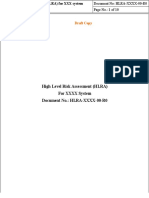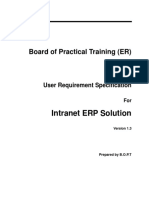Data and Database Integrity Testing
Uploaded by
Mounir Ben MohamedData and Database Integrity Testing
Uploaded by
Mounir Ben MohamedData and Database Integrity Testing
Mike KeIIy
First PubIished on SQAtester.com
What is Data and Database Integrity Testing?
Data integrity and database integrity test techniques verify that data is being stored by
the system in a manner where the data is not compromised by updating, restoration, or
retrieval processing. This type of testing is intended to uncover design flaws that may
result in data corruption, unauthorized data access, lack of data integrity across multiple
tables, and lack of adequate transaction performance (Dustin 252). The databases,
data files, and the database or data file processes should be tested as a subsystem
within the application.
Determine What To Test
The first step in determining what need to be tested is to identify the types of database
activity (insert, delete, update) that will be invoked, and to identify when these
transactions will occur within the application-under-test. t can also be helpful to work
with the application designers and architects to determine the calculations or processing
rules used by the application, as well as the time-critical transactions / functions /
conditions, and possible causes of poor performance (Dustin 136). At this time the
dataflow for the application should also be examined and tests that mimic it's path(s)
should be earmarked for planning and execution. This high level approach will set the
baseline for your test plan. t will identify the areas that you will need to investigate
further; and it will allow you to start planning for what types of testing you will need
(manual, automated, etc.).
The next step is to look in depth at the design, code, databases, and file structures.
You will want to check data fields for alphabetic and numeric characters. You will need
to look at files and fields to ensure proper spacing and length. You will want to develop
some method to verify correct data format(s). Your data consistency checks should
include both internal and external validations of essential data fields. nternal checks
involve data type checking and ensure that columns are of the correct types; external
checks involve the validation or relational integrity to determine whether duplicate data
are being loaded from different files. Also at this time you will want to be sure to plan
tests for all data files; including clip art, templates, tutorials, samples, etc.
Finally, you will want to take a look at conditions of the system that can affect the
performance or stability of the data file(s) or database(s). This will include testing
conditions like low memory, low disk space, and other limited resources. t will also
include backup integrity and recovery testing at multiple levels; including, but not limited
to, restoring individual files, restoring application data, restoring a database or other
information stores, and full system recovery.
When planning and designing your data and database tests it will be helpful if you keep
the following in mind. t is a good practice to keep backup copies of test files and test
databases. Before reporting an error, check your working copies of the input and
comparison files against the backups. Further, all data and database sub-systems
should be tested, at some point, without the target-of-test's user interface. This
removes the possibility of errors being introduced by the user interface.
Automating Data and Database Testing
There are some simple tools that can be used to automate some of the mundane tasks
needed to perform data and database testing. These tools include files comparison
utilities, files viewers, and file format converters. These tools can be used to show what
changes must be made to one comparison file in order to produce the other, compare
object code, graphics, and compressed data files, look at the data in disk files in many
different formats, and convert data files, text files, or graphic files, from one format into
another.
More complicated tools are available that can aid you in testing database connectivity,
prevent unplanned downtime and slow performance, create valid test data, improve
data movement and debugging messages, and thoroughly test proprietary database
calls, syntax and structures. These are numerous and information on them can readily
be found via Google.
Just keep in mind that automated tests should be designed to operate as stand-alone
tests. This means that the output for one test does not serve as the input to the next
test. What this allows you to do is to create a database-reset script, which is a script
that is designed to restore the database to a known baseline allowing the next test to
start at that known baseline with little to no setup required (Dustin 328).
ExampIe of Good Data Integrity Testing
The following is a vendor alert posted by Nasdaq. This alert illustrates the great pains
Nasdaq takes to ensure data integrity and stability.
"The Nasdaq Stock Market frequently disseminates test data over the Nasdaq market
data feeds during non-market hours. To prevent database corruption, market data
vendors should treat all messages received after the "End of Transmission" control
message on a Nasdaq data feed as test data. In addition, vendors should treat any
data disseminated during the weekends or market holidays as test data.
For quality assurance purposes, The Nasdaq Stock Market conducts testing of its
computer systems and telecommunications network during non-market hours.
Frequently, Nasdaq disseminates test data over the data feed circuits in order to verify
the integrity of the MCI WorldCom Intelligent Shared Network (ISN). As a result,
vendors also receive the test data over the Nasdaq data feed lines during non-market
hours.
During market hours, Nasdaq disseminates test data with a special retransmission
requester code in the message header. After-hours test data, however, does not
support this special code. Due to the testing methods utilized, after-hours test data
typically is disseminated in the same manner as an original transmission.
To insure database integrity, Nasdaq recommends that vendors treat any data received
after the "End of Transmission" control message or during non-market days as test
data. The "End of Transmission" control message is disseminated at approximately 6:37
p.m. eastern time across the Level 1 and NQDS feeds, and at approximately 5:36 p.m.
for the NTDS feed. Non-market days include weekends and holidays.
In advance of a data format change or major processing change, Nasdaq will schedule
special vendor testing opportunities. Notification of special vendor testing opportunities
and holiday will be posted to the Release Schedule on the Nasdaq TraderSM Web site.
During the designated times, vendors will be encouraged to use test data to check their
system processing. Unless otherwise instructed, however, vendors should disregard
and/or dispose of test data.."
-Vendor Alert #1998-7 - February 24, 1998
References
For more information on data and database testing would recommend the following
books. Not only do they contain useful information on data and database testing, they
both contain a wealth of information on testing techniques and theory.
Dustin, Rashka, and John Paul. Automated Software Testing. Reading: Addison-
Wesley. 1999.
Kaner, Falk, and Hung Quoc Nguyen. Testing Computer Software. Second
Edition. New York: Wiley. 1999.
You might also like
- 3 - Example Checklists and QuestionnairesNo ratings yet3 - Example Checklists and Questionnaires31 pages
- Computer System Validation (CSV) Template by ScilifeNo ratings yetComputer System Validation (CSV) Template by Scilife224 pages
- CSV Good Documentation and Test Practices For GXP0% (1)CSV Good Documentation and Test Practices For GXP16 pages
- Data Validation, Processing, and Reporting Data ValidationNo ratings yetData Validation, Processing, and Reporting Data Validation8 pages
- Appendix 1: Technical Documentation For Install and Managing A ServerNo ratings yetAppendix 1: Technical Documentation For Install and Managing A Server66 pages
- Quality Risk Management For Computerised Systems-A Review: International Journal of Pharmtech Research January 2014No ratings yetQuality Risk Management For Computerised Systems-A Review: International Journal of Pharmtech Research January 20146 pages
- Software Quality Assurance Notes in Urdu Hindi ExplanationNo ratings yetSoftware Quality Assurance Notes in Urdu Hindi Explanation5 pages
- Ignition 21 CFR Part 11 Compliance - Panacea TechnologiesNo ratings yetIgnition 21 CFR Part 11 Compliance - Panacea Technologies7 pages
- M4 - Lesson 4 - Continued Process VerificationNo ratings yetM4 - Lesson 4 - Continued Process Verification1 page
- Computerised System Validation 计算机系统验证: SOP No./编号: SOP01809/01 Page No./页码: Page 1 of 11No ratings yetComputerised System Validation 计算机系统验证: SOP No./编号: SOP01809/01 Page No./页码: Page 1 of 1111 pages
- Using Empower Systemsqt Qualification Tool For Waters Modular HPLC SystemsNo ratings yetUsing Empower Systemsqt Qualification Tool For Waters Modular HPLC Systems8 pages
- Overview of Validation Documents and ProjectsNo ratings yetOverview of Validation Documents and Projects5 pages
- 21 CFR Part11 Deployment Guide - WonderwareNo ratings yet21 CFR Part11 Deployment Guide - Wonderware70 pages
- 21CFR11 Assessment FAQ Metler Toledo STARENo ratings yet21CFR11 Assessment FAQ Metler Toledo STARE51 pages
- U R T For A Supervisory Control and Data Acquisition (SCADA) Process Control SystemNo ratings yetU R T For A Supervisory Control and Data Acquisition (SCADA) Process Control System66 pages
- Computer Systems Validation Specialist Resume Profile, Lansing, MI - Hire IT People - We Get IT Done100% (1)Computer Systems Validation Specialist Resume Profile, Lansing, MI - Hire IT People - We Get IT Done6 pages
- PICS - Guidance On GP For SC in GXP EnvironmentsNo ratings yetPICS - Guidance On GP For SC in GXP Environments54 pages
- GAMP 5 and The Supplier: Leveraging Supplier Advantage Out of ComplianceNo ratings yetGAMP 5 and The Supplier: Leveraging Supplier Advantage Out of Compliance19 pages
- Annual Product Review Process For Pharma Industry Part1No ratings yetAnnual Product Review Process For Pharma Industry Part16 pages
- 5991-8176EN Demystifying Software Validation WhitepaperNo ratings yet5991-8176EN Demystifying Software Validation Whitepaper7 pages
- Computer System Assurance: Why We Need A New Approach?100% (1)Computer System Assurance: Why We Need A New Approach?2 pages
- USP-Lifecycle Management of Analytical ProceduresNo ratings yetUSP-Lifecycle Management of Analytical Procedures15 pages
- Thank-You For Downloading The Validation Master Plan Template!No ratings yetThank-You For Downloading The Validation Master Plan Template!11 pages
- Template Spreadsheet Validation 20130418No ratings yetTemplate Spreadsheet Validation 2013041815 pages
- Guidelines For The Validation of Computerised SystemsNo ratings yetGuidelines For The Validation of Computerised Systems19 pages
- 8 Togaf 9 1 Enterprise Architecture Framework Overview m8 SlidesNo ratings yet8 Togaf 9 1 Enterprise Architecture Framework Overview m8 Slides42 pages
- 4 Togaf 9 1 Enterprise Architecture Framework Overview m4 SlidesNo ratings yet4 Togaf 9 1 Enterprise Architecture Framework Overview m4 Slides48 pages
- 6 Togaf 9 1 Enterprise Architecture Framework Overview m6 SlidesNo ratings yet6 Togaf 9 1 Enterprise Architecture Framework Overview m6 Slides57 pages
- 2 Togaf 9 1 Enterprise Architecture Framework Overview m2 SlidesNo ratings yet2 Togaf 9 1 Enterprise Architecture Framework Overview m2 Slides57 pages





































































